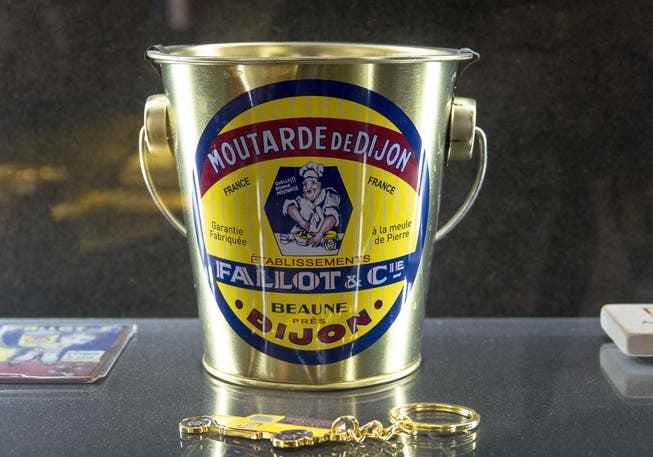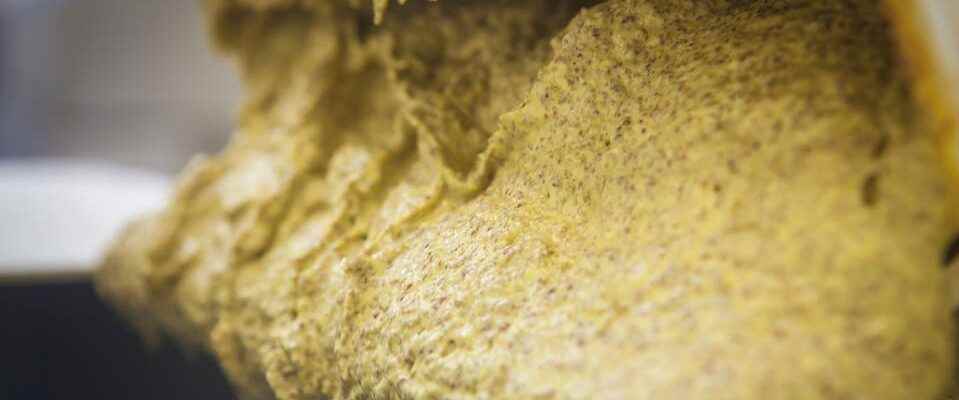Studio Arnaud Dauphin Photograph
The crisis began in early summer, and it’s not over yet: there’s no mustard in France’s supermarkets. This brings the oldest producer in the country a rush of customers, which is not just fine with him.
The house on an arterial road in the old town center of Beaune would not attract much attention if it weren’t for the facade. A delicate mustard yellow and the words “Moutarderie Fallot” in dark green reveal what has been manufactured behind the large wooden door since 1840.
In 1928, entrepreneur Edmond Fallot took over the mustard factory. It has remained in the family ever since, and Marc Désarménien, Fallot’s grandson, is extremely proud of this tradition. He has also turned it into the narrative of a brand that has established itself in the gourmet segment: not only in France, but in around 110 countries around the world. The USA and Canada, but also Germany and Japan are among the most important customers.
No more than one glass per customer
Production – although automated in the meantime – has been in the same rear building for more than 180 years, and around twenty people are employed there. In a recently inaugurated new office building right next to the historic buildings, Désarménien says that his grandfather’s recipes are still being followed today. This not only includes the right mixture of brown mustard seeds, salt and vinegar, but also the processing. At Edmond Fallot, the grains are still crushed by large millstones. Their origin is part of the trade secret.
The mustard market is a stable business, the market is slightly growing. Mustard is one of the most commonly used condiments in the world. While it is usually used as a paste in western countries, it is used more in the form of oil in Asia. Despite all these constants, Désarménien is currently experiencing something none of his ancestors had: he has to ration his product.
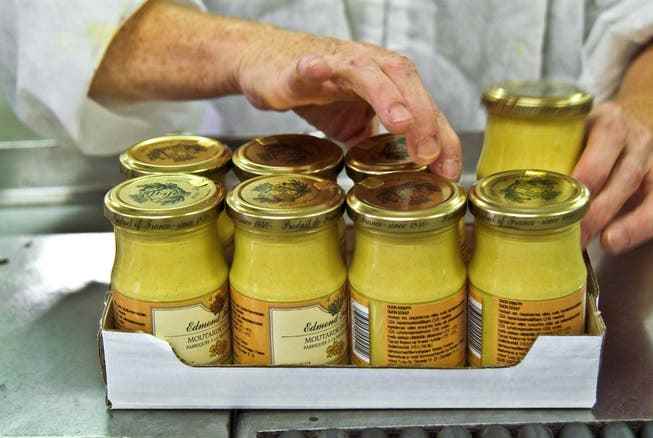
Mustard is currently a popular product. Edmond Fallot’s factory shop in Beaune currently only allows customers to purchase one glass per day.
Two glasses per customer and per day – that’s what it says in French and English on A4 sheets at the entrance gate. Until recently, only one glass per day was allowed. Because memorable scenes took place in the factory shop at the beginning of summer. Many customers came in the morning and bought in large quantities, so that the shelves were sometimes empty by the early afternoon and the shop had to be closed. Some came all the way from Paris, others tried their luck with regular visits.
The first gaps in the mustard jars of the large supermarkets appeared in May. And in the course of the summer they sometimes remained completely empty. It is still a stroke of luck when shopping to find mustard on the shelf. And this of all places in France, with around 90,000 tons per year is the largest mustard producer in Europe. In Edmond Fallot’s factory shop in Beaune, on the other hand, desperate consumers found a source that never dried up completely.
However, Marc Désarménien wasn’t really happy about this onslaught. “Actually, we’re not looking for any new customers at the moment,” he says with a smile. “For six months we have been in constant over-productivity.” However, the demand cannot be satisfied. You have to put off loyal customers, ask for patience – and have had to increase the price by around 10 percent in the first half of the year.
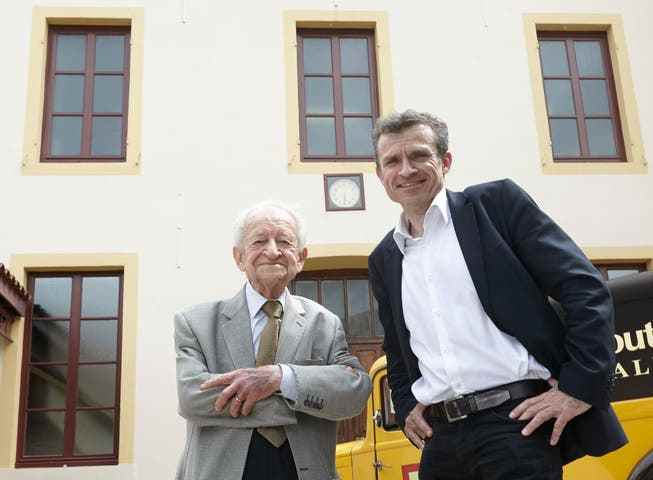
Marc Désarménien (right) took over the management of the mustard producer Fallot from his father Roger in 1994.
The reason for the shortage lies in the dependencies of the French producers. 80 percent of the mustard seeds processed in France come from Canada – and the 2021 harvest there was exceptionally poor due to an exceptional drought.
The enemy lurks in nature
Edmond Fallot is only indirectly affected. For the past three years, only mustard seeds from Burgundy have been processed in the small factory. With a certain satisfaction, Désarménien says that he was among the first to initiate the cultivation of mustard plants in the region in the mid-1990s. Mustard crops were widespread there until the Second World War, but were then abandoned in favor of oilseed rape and sunflowers and wheat, respectively.
Some Asian countries such as India and Nepal are among the largest mustard seed producers today, although they hardly export anything. In Asia, as well as in Russia and the Ukraine, white mustard is the main crop. In France, only the brown version, which is considered hotter, is processed.
The road to satisfying domestic mustard harvests is rocky. Initially, the culture was excluded from agricultural subsidies, then there was an upper limit for the areas. And finally, pests appeared. They are decimating crops, especially since the use of pesticides has been banned.
Nevertheless, Marc Désarménien wants to believe that these challenges have been mastered for the time being. The grains are not the problem, he says. They have been experimenting with hybrids for a long time and have found one that the pests like less, he says. According to Désarménien, the yields this year – the harvest always takes place in early summer – are good.
But even if he works in a growth-oriented manner, he doesn’t have the capacity to increase the volume at will, he says. And despite the increased domestic demand, around 50 percent of its production continues to go to foreign customers, because these relationships ultimately need to be cultivated. Edmond Fallot alone stopped deliveries to Russia in the spring – because of the attack on Ukraine.
The manufactory produces around 2,500 tons of mustard per year. Together with the tourist tours – after all, around 40,000 visitors a year – this will bring him around 10 million euros in sales this year. This makes Edmond Fallot one of the five most important producers in the country. But compared to the top dogs Maille or Amora, who handle two thirds of production, Fallot remains a dwarf with a share of around 5 percent. Or a David versus Goliath in the form of Unilever. The two brands now belong to the international group; he also participates in the reintroduction of local mustard crops.
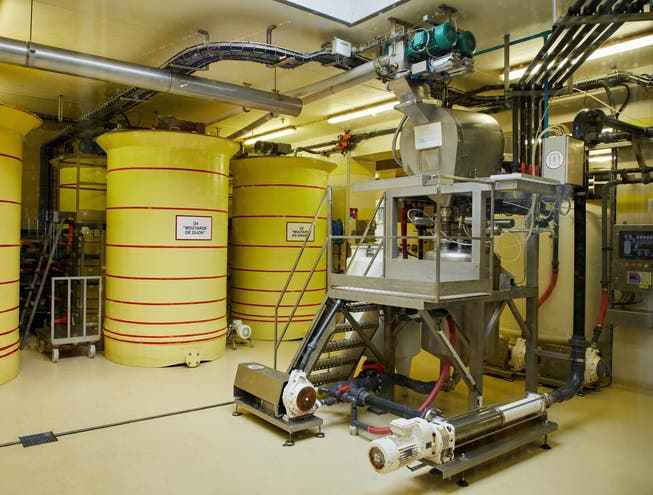
Since it was founded in 1840, the mustard factory has been located in the same rear building on an arterial road from Beaune. The mustard is stored in the barrels before it is further refined in terms of taste
Dijon mustard is not a registered trademark
Désarménien says his father was still trying to keep up with the demand from the big retailers. He finally decided on the niche: quality instead of quantity and also as local as possible. Because Désarménien is convinced that the Moutarde de Bourgogne, as he produces it, will not only continue to gain momentum because of the current situation. The designation of origin created in 2009, which stands for the processing of exclusively local ingredients – including around 16 percent wine – also meets a customer need, he says. There are now four producers in Burgundy who only use local ingredients.
The new label is also a way of distinguishing itself from Dijon mustard, despite Beaune’s close proximity to Dijon. People have been more interested in where their products came from for a few years now, Désarménien says. And they noticed more often that Dijon mustard does not necessarily come from Dijon and sometimes not even from France. He is alluding to the fact that his major competitors in particular also produce Dijon mustard in their factories abroad. This is completely legal, because “Dijon mustard” is not a protected designation of origin. First Since the year 2000, at least in France, there has been a legal definition of what is in Dijon mustard may be included – and what not.
However, Désarménien also knows that French acreage is far from being able to meet the needs of French producers. So far, only around 20 percent of the producers’ needs have been covered with the harvests.
To make matters worse, the areas cultivated with mustard plants in France have tended to decrease since 2017. Many farmers have thrown in the towel after disappointing harvests and problems with pests. Edmond Fallot and the three other local producers have now set an incentive to motivate them for the mustard culture. They have promised the farmers that they will pay twice as much for a kilo of mustard seeds in the coming year as in 2021. Their medium-term goal is to triple the area under cultivation for mustard.
New price increase in sight
The mustard shortage in France will not ease until the end of the year at the earliest – and only if the Canadian harvest is better in October. However, Désarménien points out that it was not just a shortage of mustard seeds that was the problem. The pandemic and the war in Ukraine would also have made other necessary raw materials massively more expensive: such as salt, brandy vinegar, but also glass, aluminum and cardboard. He therefore assumes that mustard prices will rise again this year: in the case of Edmond Fallot in the double-digit percentage range.
However, Désarménien does not fear that his customers will jump off him because of this. She knows what she has in his product, he says and mentions that his grandfather worked with the award-winning French restaurateur family Troisgros. Edmond Fallot was a bon vivant and the love of good food connects him with him. The man in his mid-fifties says that he doesn’t stand at the stove himself every day. But ready-made sauces for salads would never come to his table. Then he shudders: “That’s disgusting!”
